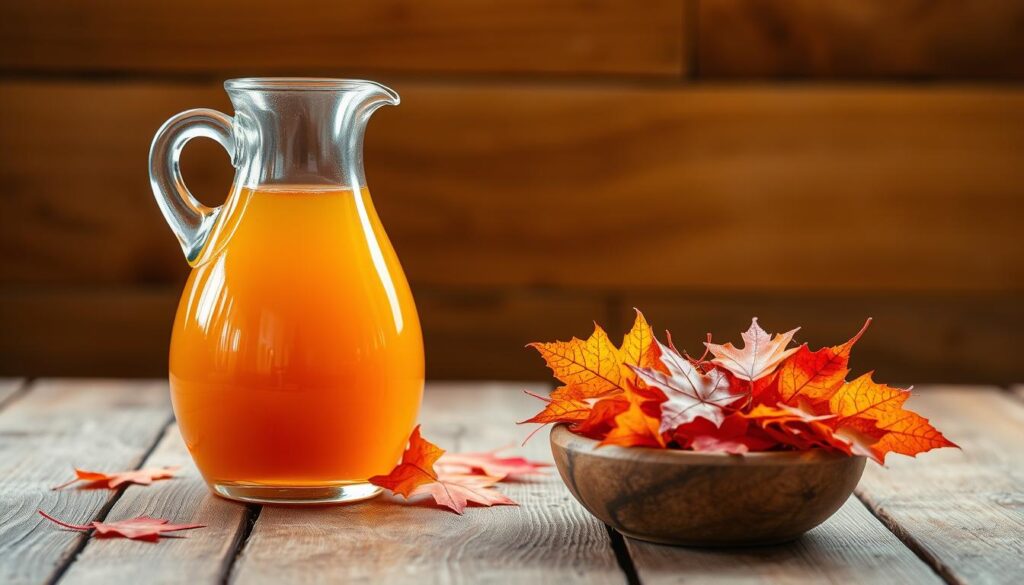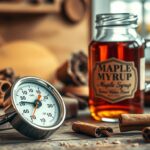Are you curious about making your own unique drinks? Making maple syrup mead could be the perfect adventure for you. This drink, also known as acerglyn, mixes maple syrup’s sweetness with honey’s richness. It creates a taste that’s both unique and enjoyable.
Creating maple syrup mead is more than just fermentation. It’s about connecting with nature and embracing traditional food-making practices. This process lets you blend two natural ingredients into a drink that’s perfect for any occasion.
Maple syrup mead has a long history that adds to its charm. It’s not just a drink; it’s a tradition that brings people together. In this article, you’ll learn about the ingredients, brewing process, and tips for making your own acerglyn recipe.
Whether you’re new to homebrewing or have experience, making maple syrup mead is an exciting journey. It invites you to explore a tradition filled with creativity and flavor. Start your journey into the world of maple syrup mead and discover its delightful taste and versatility.
Introduction to Maple Syrup Mead
Maple syrup mead is a mix of flavors that brings together the classic taste of mead and the sweetness of maple syrup. It shows how modern brewers can be creative while keeping old traditions alive. Mead has been a favorite drink for centuries, loved by many cultures.
This mead’s flavor is rich and complex. Maple syrup adds a special sweetness and depth. Drinking it feels like a warm hug, connecting us to North America’s brewing history. As more people try making their own mead, they celebrate its long-standing tradition.
What is Maple Syrup Mead?
Maple syrup mead, also known as acerglyn, is a tasty drink. It mixes honey, water, and maple syrup’s unique taste. This drink is different from regular meads because it uses maple syrup instead of just honey.
The mead definition talks about honey and water fermentation. But maple syrup adds a special touch. The mix of honey and maple syrup changes the taste, sweetness, and alcohol level. Makers can adjust this to make a mead that suits your taste, from sweet to complex.
Maple syrup mead gets its special flavor from the syrup. It adds caramel and vanilla notes. This makes the drink more interesting and appealing to fans of acerglyn.
The History of Mead and Maple Syrup
The history of mead and maple syrup is a captivating journey through time. It shows how ancient cultures valued these drinks. Mead, made from honey, was a key part of celebrations. It played a big role in social gatherings, marking it as an important part of history.
The Ancient Origins of Mead
Mead, a drink made from honey, has a long history. It was loved by the Greeks and Vikings. The Greeks thought it was divine, while Vikings used it to welcome guests.
The basic ingredients were honey, water, and sometimes fruits or herbs. This mix created a drink that brought people together.
The Role of Maple Syrup in American Traditions
Maple syrup added a new twist to mead in America. It came from the traditions of indigenous peoples. The syrup’s sweetness paired well with mead’s, making it even more special.
As settlers used local ingredients, they made unique meads. These drinks became a big part of American culture. Today, this mix is a favorite in modern brewing, keeping the traditions alive.
Ingredients Needed for Maple Syrup Mead
Making maple syrup mead needs the right ingredients. Knowing what each part does, like maple syrup and honey, is key. This section will cover what you need for great mead.
Choosing the Right Maple Syrup
Choosing the right maple syrup is important. Look for Grade A and Grade B syrups. They have a rich flavor that goes well with honey. Local sugarmakers offer fresh, high-quality syrup.
Each grade has its own taste. This can make your maple syrup mead even better.
Types of Honey for Fermentation
Honey is the main ingredient in maple syrup mead. Different honeys, like wildflower or buckwheat, add unique flavors. The honey you choose affects the taste of your mead.
Essential Equipment for Homebrewing
Before you start, get the right homebrew supplies. You’ll need:
- Fermenter with an airlock
- Sanitizer for cleaning
- Siphon for bottling
- Hydrometer to measure specific gravity
- Bottles and caps for storage
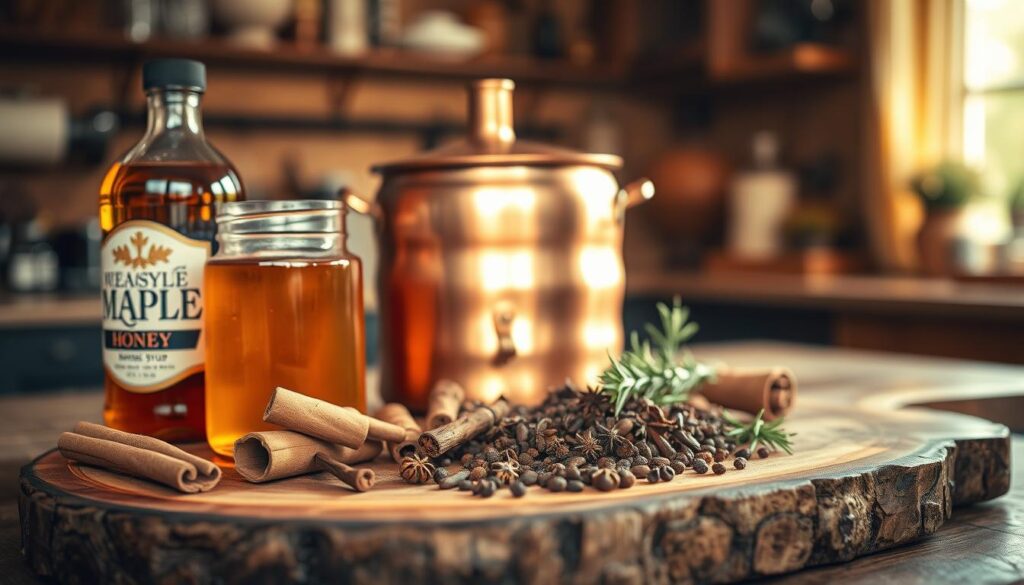
The Maple Mead Brewing Process
Learning about maple mead brewing starts with a few key steps. Keeping everything clean is the first rule. This step gets rid of bad bacteria and makes sure the fermentation area is spotless. Start by washing all your brewing tools with a safe sanitizer to keep the mead pure.
Then, it’s time to mix the ingredients. Blend pure maple syrup with honey and water to make the mead base. Stir until all the sugars dissolve. Choosing the right honey is important because it affects the taste, so pick one that goes well with maple syrup.
Next, add yeast to start fermentation. Different yeasts can change the mead’s smell and taste. Keep the fermentation area at a steady temperature, between 65°F and 75°F. This helps the fermentation process and keeps bad microbes away.
Fermentation can take weeks to months. Use a hydrometer to check the fermentation’s progress. The goal is to turn all the sugars into alcohol.
After fermentation is done, rack the mead to clear out sediment. This step improves the flavor. Some people bottle the mead right away, while others age it for more flavor. The end result is a drink that combines the sweetness of maple and honey.
| Step | Description |
|---|---|
| Sanitation | Clean all equipment with food-safe sanitizer. |
| Mix Ingredients | Combine maple syrup, honey, and water until sugars dissolve. |
| Add Yeast | Choose an appropriate yeast strain for desired flavor. |
| Temperature Control | Maintain 65°F to 75°F for optimal fermentation. |
| Fermentation Duration | Track fermentation for weeks to months until complete. |
| Racking | Transfer to a clean vessel to remove sediment. |
| Bottling/Aging | Bottle immediately or age for enhanced flavor. |
Step-by-Step Guide to Making Maple Syrup Mead
Making maple syrup mead requires a few key steps for the best taste. This guide covers everything from measuring ingredients to bottling. It’s all about the process from start to finish.
Preparation of Ingredients
The first step to a great maple mead is getting your ingredients ready. Start by measuring out the right amounts of:
- Water: About 1 gallon
- Pure maple syrup: 2-3 cups, depending on how sweet you like it
- Honey: 1 cup, choose a light or floral type
Make sure all your tools are clean and sanitized. This is important to avoid any contamination. Cleanliness is key for a good fermentation.
Fermentation Process Explained
After you’ve got your ingredients ready, it’s time to start fermenting. Mix the water, maple syrup, and honey in a clean container. Stir well to mix everything evenly.
Then, add the right yeast to start fermentation. Use an airlock to let gases out while keeping contaminants out. This step usually takes two to three weeks.
Keep the mixture in a dark, cool place. This helps the fermentation go smoothly.
Bottling and Aging Your Mead
Once fermentation is done, it’s time to bottle your mead. Siphon the mead into clean bottles, leaving the sediment behind. Seal the bottles with caps or corks.
Let the mead age for at least a month. This step makes the flavors richer and more complex. It’s all about patience and letting it develop.
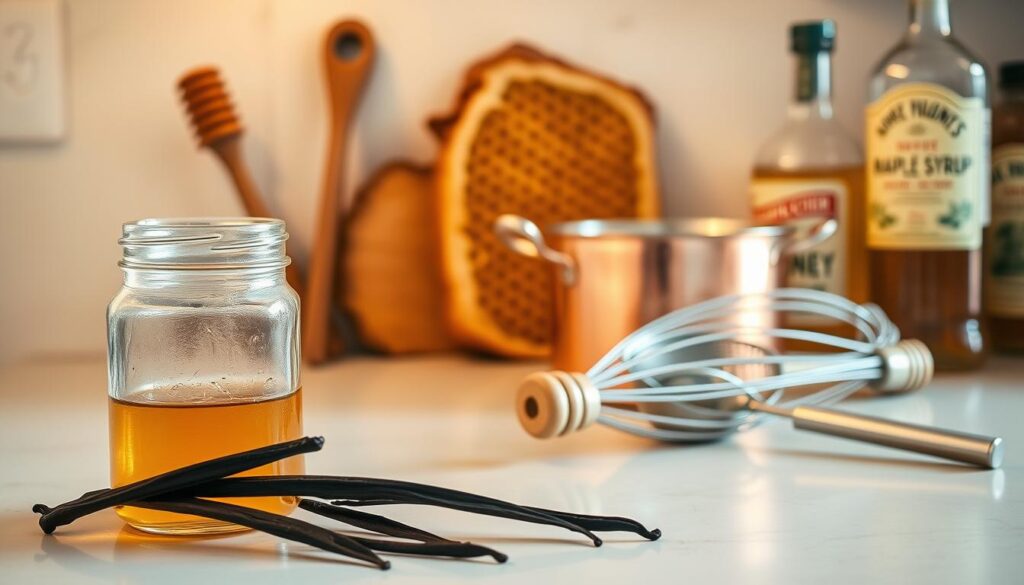
Tips for Perfecting Your Maple Mead Brewing
Mastering maple mead brewing is all about detail and creativity. Here are some tips to help you improve your brewing:
- Adjust Sweetness: Change the maple syrup to honey ratio to adjust sweetness. Start with a basic recipe and tweak it to your liking for a balanced taste.
- Flavor Enhancement: Add spices like cinnamon or ginger, or fruits like apples and berries. This can make your mead stand out.
- Optimal Fermentation: Keep the fermentation temperature between 65°F and 75°F. This helps in getting the right flavor and clarity.
- Use Quality Ingredients: Great mead starts with top-notch ingredients. Choose raw maple syrup and high-quality honey for the best flavors.
- Patience is Key: Let your mead age properly. Waiting a few extra weeks can make a big difference in taste.
Using these tips can help you make a complex and delicious maple wine. Follow these mead brewing tips and enjoy making your own unique maple mead.
Exploring Variations: Traditional and Craft Mead with Maple
The world of mead is full of flavors and styles, thanks to local ingredients like maple syrup. The Vermont acerglyn is a special example that uses local produce. We’ll look at a Vermont acerglyn recipe and explore craft mead variations with fermented maple honey.
Vermont Acerglyn Recipe
Vermont acerglyn mixes honey and maple syrup for a unique taste. The maple syrup used is key, so choose a high-quality one with a deep color and strong taste.
To make a Vermont acerglyn, you’ll need:
- 3 pounds of honey
- 2 quarts of maple syrup
- 4 gallons of water
- Yeast for mead fermentation
- Optional spices like cinnamon or vanilla for extra flavor
With the right ingredients, you can make a balanced mead that highlights honey and maple. For more ideas, check out regional mead recipes online.
Fermented Maple Honey Insights
Craft mead often uses fermented maple honey for extra flavor and sweetness. This adds nutrients like manganese and zinc from the maple syrup. Both maple syrup and honey have antioxidants, making the mead healthier.
When making craft mead, try different maple syrups and honeys. Each one changes the flavor, letting you create unique meads that show off local tastes.
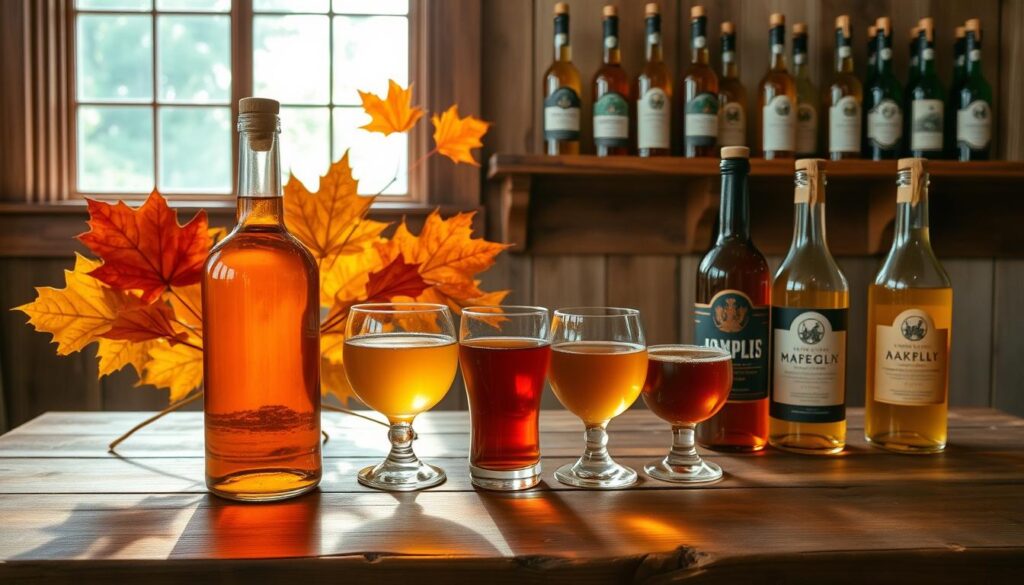
Common Mistakes in Maple Mead Brewing
Brewing maple mead is a great chance to make a unique drink. But, it has its own set of challenges. Knowing common mistakes can make the brewing process better. Understanding fermentation pitfalls helps homebrewers get the best flavors and smells from their ingredients.
Over-fermentation: What to Watch For
Over-fermentation is a big problem in mead brewing. It can make the drink taste bad and less sweet. Signs of over-fermentation include:
- Excessively dry taste that masks the maple syrup’s natural sweetness.
- High alcohol content, often leading to a hot finish.
- Flat or muted flavors diminishing the taste complexity.
To avoid over-fermentation, it’s important to watch the fermentation time. Taste tests during fermentation can help find the right balance. This is a key tip for making great mead.
Quality Control in Ingredients
The quality of ingredients is very important for maple mead. Bad honey or syrup can ruin the taste. Key things to consider are:
- Choosing pure maple syrup without additives or artificial flavors.
- Selecting high-quality honey suitable for fermenting.
- Ensuring all equipment is sanitized to prevent contamination.
By focusing on quality, you can avoid common problems. This makes the mead more enjoyable to drink.
| Common Mistakes | Consequences | Prevention Strategies |
|---|---|---|
| Over-fermentation | Dry taste, high alcohol content | Monitor fermentation time, taste during fermentation |
| Poor quality ingredients | Off-flavors, poor aroma | Use pure maple syrup and high-quality honey |
| Insufficient sanitation | Contamination, spoilage | Thoroughly sanitize all equipment |
Storing and Serving Your Maple Syrup Mead
Storing and serving maple syrup mead right is key to keeping its flavors fresh. Good storage tips help keep your mead tasting great. With the right steps, your mead will stay delicious for a long time.
Optimal Storage Conditions
Here are some tips for storing your maple syrup mead:
- Use glass containers to keep flavors intact.
- Store it in a fridge with a temperature between 32°F and 40°F.
- Seal containers tightly to prevent mold and contamination.
- Freeze it in airtight containers for long-term storage, leaving room for expansion.
- Check for mold, cloudiness, or bad smells regularly.
For more mead storage tips, keeping the right conditions ensures top quality.
Best Practices for Serving Temperature
The right serving temperature is important for maple syrup mead’s flavor. Here are some tips for the best taste:
- Serve it chilled for a refreshing taste on hot days.
- Let it warm up a bit for a more aromatic taste in cold weather.
- Use special glassware to keep it at the right temperature and look great.
By following these tips, you’ll enjoy your mead’s complex flavors and aromas.
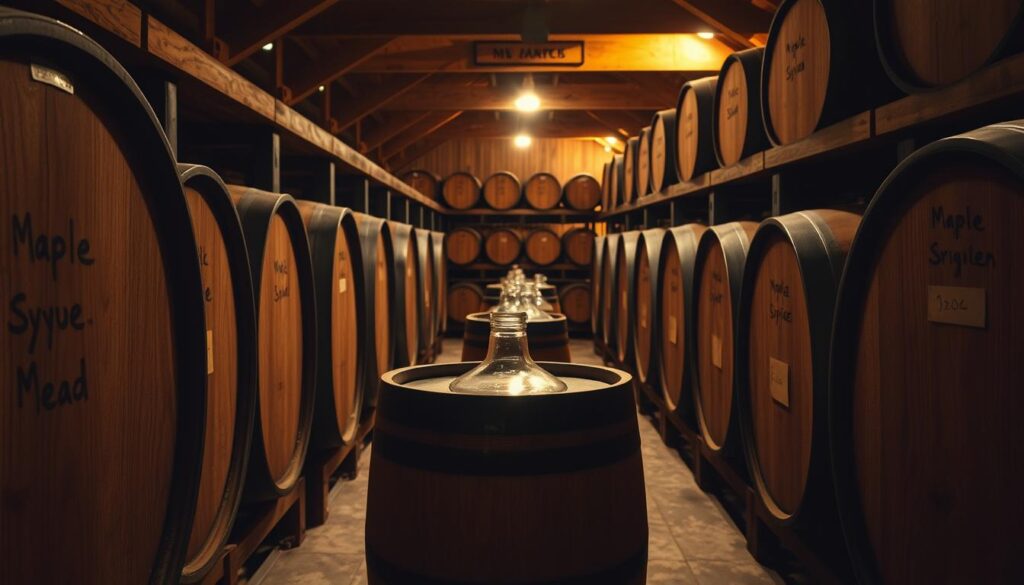
Pairing Maple Syrup Mead with Food
Maple syrup mead adds a special touch to any meal. Its sweet and floral taste makes it great with many foods. Exploring different pairings can really enhance your dining experience.
Complementary Flavors to Enhance Your Experience
Pairing food with maple syrup mead brings out its rich flavor. Here are some top pairings to try:
- Cheeses: Soft cheeses like brie or goat cheese are a perfect match. Sharp cheddar adds a nice depth.
- Charcuterie: Salty meats like prosciutto or salami balance the mead’s sweetness.
- Grilled Vegetables: Roasted bell peppers, zucchini, and asparagus pair well with the honey notes.
- Desserts: Maple syrup mead is great with caramel or vanilla desserts, making for a sweet finish.
Creative Cocktail Ideas with Maple Mead
Mixing maple syrup mead into cocktails is a fun idea. Here are some creative drinks to try:
- Maple Mule: Mix mead with ginger beer and lime juice over ice.
- Autumn Spritzer: Combine mead with sparkling water, add apple slices, and a sprinkle of cinnamon.
- Maple Sour: Blend mead with lemon juice and a bit of bitters for a zesty drink.
| Food Pairings | Complementary Flavors |
|---|---|
| Brie Cheese | Soft and creamy, enhances the sweetness of mead |
| Prosciutto | Salty, balances the sweetness |
| Grilled Asparagus | Earthy, complements floral notes |
| Caramel Dessert | Rich, pairs well with honey flavors |
Conclusion
Making maple syrup mead is both rewarding and enriching. This article has covered everything from choosing the best maple syrup and honey to the fermentation and bottling steps. Each step lets you dive into the craft of homebrewing and explore unique flavors.
Creating your own maple syrup mead lets you try out many variations and personal touches. You can stick to traditional recipes or try new, exciting combinations. This journey is a great way to celebrate the rich traditions and tastes of this special drink.
The joy of brewing maple syrup mead comes from both the process and enjoying the final product. So, get your ingredients ready, set up your equipment, and start making your own maple syrup mead!

